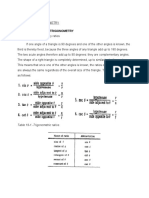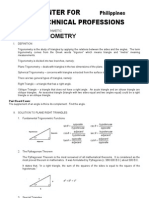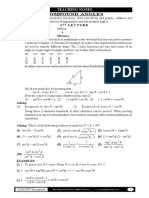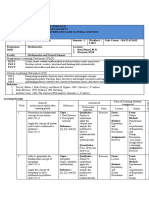A, A+d, A+2d, : NTH Term of The Arithmetic Sequence A, A+d, A+2d, Is
A, A+d, A+2d, : NTH Term of The Arithmetic Sequence A, A+d, A+2d, Is
Uploaded by
FSR Uwu2419Copyright:
Available Formats
A, A+d, A+2d, : NTH Term of The Arithmetic Sequence A, A+d, A+2d, Is
A, A+d, A+2d, : NTH Term of The Arithmetic Sequence A, A+d, A+2d, Is
Uploaded by
FSR Uwu2419Original Title
Copyright
Available Formats
Share this document
Did you find this document useful?
Is this content inappropriate?
Copyright:
Available Formats
A, A+d, A+2d, : NTH Term of The Arithmetic Sequence A, A+d, A+2d, Is
A, A+d, A+2d, : NTH Term of The Arithmetic Sequence A, A+d, A+2d, Is
Uploaded by
FSR Uwu2419Copyright:
Available Formats
M.
Subhan
III. Sequence, Series, and Trigonometry
Arithmetic Sequence/Progression
An arithmetic sequence is a sequence of the form
a, a+d, a+2d, …
The number a is the first term, and d is the common difference of the sequence.
The difference between two consecutive terms is d
an − an−1 = d
——————————
The nth Term of an Arithmetic Sequence
The nth term of the arithmetic sequence a, a+d, a+2d, … is
a + (n-1) d
a1, a2, a3 are the first three terms.
a(n+1)/2 is called middle term.
an and an+1 are two consecutive terms
——————————
Partial sum of Arithmetic Sequence
For arithmetic sequence a, a+d, a+2d, …, the nth partial sum
Sn = (n/2)(2a + (n − 1)d)
or
Sn = (n/2)(a + an)
——————————
Geometric Sequence
a, ar, ar2, … is a geometric sequence
a1=a is the first term.
an=arn-1 is the n-th term of the geometric sequence.
r is the common ratio.
——————————
Partial Sum of Geometric Sequence
Let Sn be the partial sum of the geometric sequence. Then
Sn = a + ar + ar2 + … + arn−1
rn 1
or Sn= a
r 1
——————————
English for Math III-1
M.Subhan
The sum of finite or infinite sequence
an = a1 + a2 + ..
is called series.
Practice
1. Find the first 6 terms and the 300th term of the arithmetic sequence 13,7....
2. The 10th term of an arithmetic sequence is 55 and the 2nd term is 7. Find the
1st term.
3. Find the sum of the first 40 terms of the arithmetic sequence 3,7,11,15...
4. Find the 8th term of the geometric sequence 5,15,45.....
5. The 3rd term of a geometric sequence is 63/4, and the 6th term is 1701/32.
Find the 8th term.
6. Find the sum of the first 5 terms of the geometric sequence 1, 0.7, 0.49,
0.343,...
Trigonometry
Trigonometry is the study of angle measurement.
When you have a right triangle there are 5 things we can know about it : the
lengths of the sides (A, B, and C), and the measures of the acute angles (a
and b)
b
C
A
a
B
Some terminology:
The hypotenuse will always be the longest side, and opposite from the right
angle.
The opposite side is the side directly across from the angle you are
considering (angle a).
The adjacent side is the side next to angle you are considering.
The Trigonometric Functions
Sin x = Opposite side/Hypotenuse
English for Math III-2
M.Subhan
Cos x = Adjacent side/Hypotenuse
Tan x = Opposite side/Adjacent side
Here is a way to remember how to make the 3 basic Trig Ratios
SOHCAHTOA is pronounced “Sew Caw Toe A” and it means
Sin is Opposite over Hypotenuse,
Cos is Adjacent over Hypotenuse,
and Tan is Opposite over Adjacent
We can use the mnemonic
Silly Old Hen, Cackles And Howls, Till Old Age.
Cot a = adjacent side/opposite side
Sec a = hypotenuse/adjacent side
Csc a = hypotenuse/opposite side
This relationship can be summarized:
1 1 1
sin cos tan
csc sec cot
1 1 1
csc sec cot
sin cos tan
Practice
Fill the table below and say the equation, such as sin(00)=….
Degrees Radians Sin Cos Tan
0 0
30 π/6
45 π/4
60 π/3
90 π/2
Periodicity
The trigonometric functions are periodic. The sine and cosine functions have the
period 2π (3600); the tangent and cotangent functions have the period π (1800).
Quadrant relations.
All functions have positive values for angles in Quadrant I, Sine and Cosecant
have positive values for angles in Quadrant II, Tangent and Cotangent have
English for Math III-3
M.Subhan
positive values for angles in Quadrant III, Cosine and Secant have positive
values for angles in Quadrant IV.
It will help to memorize by learning these words in Quadrants I - IV:
“All students take calculus”
And remembering reciprocal identities
students all sin (csc) all
take calculus tan (cot) cos (sec)
The Formulas for Addition and Subtraction
sin(A + B) = sin A cos B + cos A sin B
sin(A - B) = sin A cos B - cos A sin B
cos(A + B) = cos A cos B - sin A sin B
cos(A - B) = cos A cos B + sin A sin B
tan(A + B) = tan A + tan B / (1 - tan A tan B)
tan(A - B) = tan A - tan B / (1 + tan A tan B)
The Phytagorean Identities
sin2 cos 2 1
1 cot 2 csc 2
tan2 1 sec 2
The Formulas for Double Angles
sin 2A = 2 sin A cos A
cos 2A = cos2 A – sin2 A
tan 2A = 2 tan A / (1 – tan2 A)
The Formulas for Half Angles
1 cos
sin
2 2
1 cos
cos
2 2
1 cos
tan
2 1 cos
English for Math III-4
M.Subhan
The Sine Rule
Sin A Sin B Sin C
= = c
a b
B
c
a
A C
b
The Cosine Rules
a² = b² + c² - 2bc cos A B
c
b² = a² + c² - 2ac cos B
a
c² = a² + b² - 2ab cos C
A C
Sometimes when we use right triangles to model real-life situations, we use the
terms angle of elevation and angle of depression.
If you are standing on the ground and looking up at a hot air balloon, the angle
that you look up from ground level is called the angle of elevation. If someone is in
the hot air balloon and looks down to the ground to see you, the angle that they have
to lower their eyes, from looking straight ahead, is called the angle of depression.
Balloon
Angle of
depression
Angle of
elevation
You
Practice
1. Without using calculator, find cos(150).
2. Find the values of x for which sin 3x = 0.5 if it is given that 0 < x < 900.
3. What is the equal value in degrees for x radians?
English for Math III-5
M.Subhan
Glossaries
Words Pronunciations
arithmetic /ə'rɪθmətɪk/
common /'kɒmən/
consecutive /kən'sekjʊtɪv/
difference /'dɪfrəns/
finite /'faɪnaɪt/
geometric /dƷɪə'mətrɪk/
infinite /'ɪnfɪnət/
middle /'mɪdl/
partial /'pɑ:∫l/
progression /'prə'gre∫n/
ratio /'reɪ∫ɪəʊ/
sequence /'si:kwəns/
series /'sɪəri:z/
term /tɜ:m/
Symbols Words Pronunciations
sin x sine x /saɪn/
cos x cos x; cosine x /kɒz/;/kɒzaɪn/
tan x tan x; tangent x /tæn/;/tændƷənt/
sec x sec x /sek/
csc x cosec x /'kəʊsek/
cot x cotangent x /'kəʊtændƷənt /
adjacent /ə'dƷeɪsnt/
angle /'æŋgl/
degrees /dɪ'gri:z/
hypotenuse /haɪ'pɒtənyu:z/
identity /aɪ'dentətɪ/
opposite /ɒpəzɪt/
period /'pɪərɪəd/
quadrant /'kwɒdrənt/
radian /'rəɪdɪən/
reciprocal /rɪ'siprəkl/
trigonometry /trɪgə'nɒmətrɪ/
English for Math III-6
M.Subhan
Greek Alphabets
Α α alpha /'ælfə/
Β β beta /'bi:tə/
Γ γ gamma /'gæmə/
Δ δ delta /'deltə/
Ε ε epsilon /'epsilən/
Ζ ζ zeta /'ziːtə/
Η η eta /'iːtə/
Θ θ theta /'θiːtə/
Ι ι iota /aɪ'əʊtə/
Κ κ kappa /'kæpə/
Λ λ lamda /'læmdə/
Μ μ mu /'mjuː/
Ν ν nu /'njuː/
Ξ ξ xi /'ksaɪ/
Ο ο omicron /'əʊmɪkrən/
Π π pi /'paɪ/
Ρ ρς rho /'rəʊ/
Σ σ sigma /'sɪgmə/
Τ τ tau /'tɑʊ /
Υ υ upsilon /'jʊpsɪlən/
Φ φ phi /'faɪ/
Χ χ chi /'kaɪ/
Ψ ψ psi /'psaɪ/
Ω ω omega /'əʊmɪgə/
English for Math III-7
You might also like
- Richard Herrmann Fractional Calculus An Introduction For Physicists World Scientific 2011 PDFDocument274 pagesRichard Herrmann Fractional Calculus An Introduction For Physicists World Scientific 2011 PDFKgotsofalang Kayson NqhwakiNo ratings yet
- Paper-1: Module-10: Trigonometry: Foundations of BiophysicsDocument8 pagesPaper-1: Module-10: Trigonometry: Foundations of BiophysicsGenevieve MerroNo ratings yet
- Theory of TrigonometryDocument26 pagesTheory of Trigonometrysyerry_179No ratings yet
- Ex 4 TrignometryDocument18 pagesEx 4 TrignometryDivya AngelNo ratings yet
- RATIOS 1 FDocument49 pagesRATIOS 1 Fshauryaks170No ratings yet
- Trigonometric FunctionsDocument10 pagesTrigonometric FunctionsEdi MuhammNo ratings yet
- Wikimama Class 11 CH 2 TrigonometryDocument6 pagesWikimama Class 11 CH 2 TrigonometryWikimamaNo ratings yet
- Module 1 in MfeDocument9 pagesModule 1 in Mfevantae SmithNo ratings yet
- TrignometryDocument12 pagesTrignometryVardaan ThakurNo ratings yet
- 2021 HS G8 S2 Trigonometry1 SCDocument3 pages2021 HS G8 S2 Trigonometry1 SCalex jobogNo ratings yet
- Trigonometry FinalDocument8 pagesTrigonometry FinalVholts Villa VitugNo ratings yet
- Nda Trigonometry Solution 40Document31 pagesNda Trigonometry Solution 40taransaini748No ratings yet
- TrigonometryDocument56 pagesTrigonometryRahul DhakadNo ratings yet
- Trigonometric Formula of Class 11Document5 pagesTrigonometric Formula of Class 11Red MediaNo ratings yet
- Trigonometry Notes, Definitions, and Formulae DefinitionsDocument6 pagesTrigonometry Notes, Definitions, and Formulae DefinitionsJulie Ailene AsuncionNo ratings yet
- Trig No Me TryDocument10 pagesTrig No Me Trysiddhartha1994No ratings yet
- Trogonometry BookDocument16 pagesTrogonometry Bookmazhar10325No ratings yet
- CH 6 TrigonometryDocument100 pagesCH 6 TrigonometryMin Chong100% (2)
- Chapt 7 - TrigonometryDocument46 pagesChapt 7 - TrigonometryJeremiah NakibingeNo ratings yet
- SAT II Math Level 2 Subject Test Notes: Trigonometric FunctionsDocument4 pagesSAT II Math Level 2 Subject Test Notes: Trigonometric Functionstomcantyyy100% (1)
- Maths in Focus - Margaret Grove - ch6Document78 pagesMaths in Focus - Margaret Grove - ch6Sam Scheding50% (4)
- Lessson 9 TrigonometryDocument11 pagesLessson 9 Trigonometryjamesmorara3No ratings yet
- TrigonometryDocument14 pagesTrigonometryChrysler DuasoNo ratings yet
- Simplified Approach To Oblique Triangles LAW of COSINES and The LAW of SINESDocument10 pagesSimplified Approach To Oblique Triangles LAW of COSINES and The LAW of SINESBernard FloresNo ratings yet
- Trigonometry: By: Rushikesh ReddyDocument20 pagesTrigonometry: By: Rushikesh ReddyfunshoadeyekunNo ratings yet
- Innovative Aviation Training Services: TrigonometryDocument11 pagesInnovative Aviation Training Services: TrigonometrynathanNo ratings yet
- Trig1 - Compound Angles - TN - FDocument20 pagesTrig1 - Compound Angles - TN - FSaurabh SharmaNo ratings yet
- Chapter 1 - Guided Notes To TrigonometryDocument10 pagesChapter 1 - Guided Notes To TrigonometryfallonNo ratings yet
- Class05 MCu11 Notes Mar 05-10Document11 pagesClass05 MCu11 Notes Mar 05-10jessicayou1031No ratings yet
- Unit 1 - Solution of Triangles NotesDocument7 pagesUnit 1 - Solution of Triangles NotesKutloano MoloiNo ratings yet
- Trigonometry PDFDocument12 pagesTrigonometry PDFSantosh SinghNo ratings yet
- Trigonometry RevisionDocument4 pagesTrigonometry RevisionKin Wai CheahNo ratings yet
- 4 4 App Trig To TRDocument14 pages4 4 App Trig To TRAudrey LeeNo ratings yet
- Spherical Lec JowDocument37 pagesSpherical Lec JowWassan IdreesNo ratings yet
- Trigonometric Formulas - Handy Summary Sheet: 1 0 0 0 Cos SinDocument2 pagesTrigonometric Formulas - Handy Summary Sheet: 1 0 0 0 Cos SinMd. Humayun KobirNo ratings yet
- TrigonometryDocument29 pagesTrigonometryAileen Grace Delima100% (11)
- 1-Basic Mathematics-01-TheoryDocument37 pages1-Basic Mathematics-01-TheoryRaju SinghNo ratings yet
- 8.0 Trigonometry TheoryDocument38 pages8.0 Trigonometry TheoryPramodLomateNo ratings yet
- 1-6 Law of Sine and CosineDocument20 pages1-6 Law of Sine and CosineshaikhahalrefaeNo ratings yet
- MATH 9 Q4 MELC 1 To 4Document27 pagesMATH 9 Q4 MELC 1 To 4Ella de la Cruz Gulanes100% (1)
- Trigonometry Trigonometry Trigonometry: Mathematics Project Mathematics ProjectDocument8 pagesTrigonometry Trigonometry Trigonometry: Mathematics Project Mathematics ProjectnagpalanishNo ratings yet
- Pre Calculus TrigonometryDocument77 pagesPre Calculus TrigonometryTeacher JasonNo ratings yet
- Chapter 11Document10 pagesChapter 11Padala Raghu Rama Reddy100% (1)
- Lesson Plan Trigo Class X by ManishaDocument20 pagesLesson Plan Trigo Class X by Manishamansiha agrawal83% (18)
- Mathematics N3 Trigonomentry Tutorial Notes PDFDocument15 pagesMathematics N3 Trigonomentry Tutorial Notes PDFKatlego MofommeNo ratings yet
- Trigonometry L10Document4 pagesTrigonometry L10Sabina N.No ratings yet
- Trigonometry Formulas & Identities - Complete List of Trigonometric Formulas (Class 10 To 12)Document6 pagesTrigonometry Formulas & Identities - Complete List of Trigonometric Formulas (Class 10 To 12)ambresh.09No ratings yet
- Pre Calculus Q4 Week 3 Circular FunctionsDocument28 pagesPre Calculus Q4 Week 3 Circular Functionsyuhikurenai6524No ratings yet
- Group 5 - VM3 ProjectDocument42 pagesGroup 5 - VM3 ProjectDHRUVNo ratings yet
- Trigonometric Identities and Equation EngDocument33 pagesTrigonometric Identities and Equation Engchirag2796100% (1)
- Math 9 q4 Week 1Document6 pagesMath 9 q4 Week 1Millet Castillo100% (1)
- Procbse 20241027 105515 0000Document8 pagesProcbse 20241027 105515 0000abhik09919No ratings yet
- Prepared by Maricel G. LoDocument19 pagesPrepared by Maricel G. LoAna Rose S. LlameraNo ratings yet
- Intermediate GeometryDocument16 pagesIntermediate GeometryD.SREEPRANAD 7a2020No ratings yet
- Lesson 4-8 Stem 1BDocument15 pagesLesson 4-8 Stem 1BJune Patricia AraizNo ratings yet
- Trigonometric Ratios to Transformations (Trigonometry) Mathematics E-Book For Public ExamsFrom EverandTrigonometric Ratios to Transformations (Trigonometry) Mathematics E-Book For Public ExamsRating: 5 out of 5 stars5/5 (1)
- De Moiver's Theorem (Trigonometry) Mathematics Question BankFrom EverandDe Moiver's Theorem (Trigonometry) Mathematics Question BankNo ratings yet
- A-level Maths Revision: Cheeky Revision ShortcutsFrom EverandA-level Maths Revision: Cheeky Revision ShortcutsRating: 3.5 out of 5 stars3.5/5 (8)
- Mathematical Analysis 1: theory and solved exercisesFrom EverandMathematical Analysis 1: theory and solved exercisesRating: 5 out of 5 stars5/5 (1)
- I. Numbers and Arithmatic Operations: Numbers (Bilangan) Natural Numbers (Bilangan Asli)Document13 pagesI. Numbers and Arithmatic Operations: Numbers (Bilangan) Natural Numbers (Bilangan Asli)FSR Uwu2419No ratings yet
- Differential Calculus 2021 Lesson PlanDocument5 pagesDifferential Calculus 2021 Lesson PlanFSR Uwu2419No ratings yet
- Simple and Compound Interest V.01Document13 pagesSimple and Compound Interest V.01FSR Uwu2419No ratings yet
- Nominal Rate of Interest v.01Document13 pagesNominal Rate of Interest v.01FSR Uwu2419No ratings yet
- L6 Trigonometric IdentitiesDocument20 pagesL6 Trigonometric IdentitiesLorenzo Abolar100% (1)
- Cambridge Intl As A Level P1 Maths 196337 Answers OnlyDocument42 pagesCambridge Intl As A Level P1 Maths 196337 Answers OnlyAli RaamizNo ratings yet
- Study Materials: Vedantu Innovations Pvt. Ltd. Score High With A Personal Teacher, Learn LIVE Online!Document9 pagesStudy Materials: Vedantu Innovations Pvt. Ltd. Score High With A Personal Teacher, Learn LIVE Online!Amit SolankiNo ratings yet
- Trigonometry (Exercise For Cintya)Document6 pagesTrigonometry (Exercise For Cintya)ybandik adicahyonoNo ratings yet
- Maths - Complex NumbersDocument12 pagesMaths - Complex Numbersblue_l1No ratings yet
- Wallis FormulaDocument6 pagesWallis FormulaAlwin Palma jrNo ratings yet
- Derivatives of Trigonometric FunctionsDocument2 pagesDerivatives of Trigonometric FunctionsJeanny Mae PesebreNo ratings yet
- Complex L-8Document64 pagesComplex L-8Anindya Vikram SinghNo ratings yet
- Trigidentities1 PDFDocument4 pagesTrigidentities1 PDFWidi Toss Muda PurwodadiNo ratings yet
- SHM (AG Sir) 31-07-09 Teaching NotesDocument22 pagesSHM (AG Sir) 31-07-09 Teaching NotesSankar KumarasamyNo ratings yet
- Grade 10 Math Exam ReviewDocument36 pagesGrade 10 Math Exam ReviewBrendanJHiggins84% (19)
- The Fourier Transform: Jean Baptiste Joseph FourierDocument22 pagesThe Fourier Transform: Jean Baptiste Joseph FourierAbhinav_Batish_1810No ratings yet
- Chap 2 Signals and Signal Space Spring 2017 IIDocument96 pagesChap 2 Signals and Signal Space Spring 2017 IINayim MohammadNo ratings yet
- Examiner's Report Principal Examiner Feedback: Pearson Edexcel International A Level in Pure Mathematics P2 (WMA12/01)Document10 pagesExaminer's Report Principal Examiner Feedback: Pearson Edexcel International A Level in Pure Mathematics P2 (WMA12/01)Ishy HereNo ratings yet
- Mathematics Past Question and Answer For Pre-University StudentsDocument97 pagesMathematics Past Question and Answer For Pre-University StudentsChristopher Olasupo100% (1)
- Crosswind and Headwind Calculation - IVAO - International Virtual Aviation OrganisationDocument5 pagesCrosswind and Headwind Calculation - IVAO - International Virtual Aviation OrganisationArie ArifinNo ratings yet
- EEC 652 DSP LabDocument10 pagesEEC 652 DSP LabShitansh NigamNo ratings yet
- Seeing Solar Storms in STEREO - II: Problem 1 - The Astronomers Want To Know The Distance That The CME Is From EarthDocument2 pagesSeeing Solar Storms in STEREO - II: Problem 1 - The Astronomers Want To Know The Distance That The CME Is From EarthpianomagicianNo ratings yet
- Appendix A Trigonometric Identities For ThreePhase Systems PDFDocument13 pagesAppendix A Trigonometric Identities For ThreePhase Systems PDFAlberto JimenezNo ratings yet
- EA II - Note 1 PDFDocument9 pagesEA II - Note 1 PDFNo VaNo ratings yet
- Fismat 361-370Document19 pagesFismat 361-370Yogi Firman AndikaNo ratings yet
- Horizontal Milling Machine CW Gear Hobbing Attachment12Document225 pagesHorizontal Milling Machine CW Gear Hobbing Attachment12QUANG LÊNo ratings yet
- 00 Full GATE ME HandbookDocument454 pages00 Full GATE ME HandbookRahul JotwaniNo ratings yet
- Lecture 9 Response To General Dynamic LoadingDocument12 pagesLecture 9 Response To General Dynamic LoadingTUAMIGOVANCITONo ratings yet
- Basic Tubing ForcesDocument21 pagesBasic Tubing ForcesOzzie GonzalezNo ratings yet
- 7.4 Notes Double-Angle and Half-Angle IdentitiesDocument6 pages7.4 Notes Double-Angle and Half-Angle IdentitiesLuke Rodriguez100% (1)
- Unit-1 Vehicle Frame and SuspensionDocument41 pagesUnit-1 Vehicle Frame and SuspensionKrishna 1996No ratings yet
- Math 101 Ps 1Document3 pagesMath 101 Ps 1Muhammed TuncerNo ratings yet
- To Perform Signal Operations On Continuous Time and Discrete Time Signals Using MATLAB.Document16 pagesTo Perform Signal Operations On Continuous Time and Discrete Time Signals Using MATLAB.LUKESH ankamwarNo ratings yet





























































































